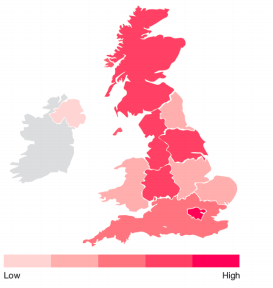https://youtu.be/64jz5anW2Cs
New research from Nesta Challenges’ Flying High programme, which analyses how drones can provide benefits to UK cities, reveals that the use of drones – for services such as blood sample transport by regional pathology units and the NHS – could save the public sector £1.1 bn by 2035.
The report, “Flying high – Seizing the opportunity”, commissioned by Nesta Challenges’ Flying High programme – which is supported by Innovate UK – and with economic forecasting by PwC, looks into the economic benefits to the UK public sector.
In addition to the savings, the report found that drones to support the delivery of public services in urban areas could increase UK GDP by £6.9 billion in the next 15 years.
According to the report, drones could bring significant cost savings to the public and increase efficiencies for local councils providing public services. For example, they could support faster, more efficient transportation of medical supplies or blood samples, replacing the need for costly road transport vehicles, or help emergency services, like fire and police, to assess a scene before they arrive.
Drones could encourage innovative approaches to infrastructure maintenance and work too, alleviating pressure on councils finding resources for jobs that are more labour-intensive.
Of the UK’s largest cities, London, Birmingham and Leeds would have an increased GDP of £1.4bn, £687m and £320m respectively, with cost savings of £115m (Birmingham), £53m (London) and £53m ( Leeds).
Top cities where Public Sector could be impacted by drone technology
(Source: Nesta Challenge’s Seizing the Opportunity report)
| Local Authority | Cost Saving | GDP impact |
| Birmingham | £115million | £687million |
| London | £53million | £1.4billion |
| Leeds | £53million | £320million |
| Manchester | £37million | £222million |
| City of Edinburgh | £35million | £212million |
| City of Bristol | £25 million | £151 million |
| Nottingham | £14 million | £82 million |
| Leicester | £14 million | £85 million |
| Southampton | £7 million | £41 million |
| Bradford | £19 million | £116 million |
GDP impact in the public sector by region
A map showing the GDP impact in public sector across the UK shows how significant the impact would be, with public sector in the North of the UK benefiting substantially from the new technology.
Tris Dyson, Executive Director of Nesta Challenges, which manages Flying High, said:
“Drones delivering public services in cities could be part of our reality in the near future, bringing major benefits for the public sector.
“This is a great opportunity but cities and the public they represent will be critical in enabling the development of these urban drone services. If we can integrate technology, regulation, city leadership, public services and public engagement, we will help position the UK as a global leader in developing urban drone services and will unlock the significant economic opportunity for our future.”
Elaine Whyte, UK Drones Lead for PwC, said:
“From this new research, we can see that the potential benefits of drones are not limited to business and that the public sector can achieve significant cost savings by applying drone technologies to the challenges that local authorities face. Whilst there are disparities across the regions, it is pleasing to see that every region in the UK can financially benefit by adopting and deploying drone technologies.
“The benefits and value of drone technology are undeniable, however public perception remains low and awareness of drone potential even lower. It is clear now that we need a nationwide drones vision and strategy to turn these figures into a reality.”
A CGI video, showing how drones could be used by public services, has been created by Flying High to encourage discussion about possible uses of drones in the UK.
The video shows three different scenarios where drones are used to benefit society, including the transportation of medical equipment to paramedics at the scene of a crash, a drone providing data back to fire services after analysing a building on fire and spotting a fault line on a railway path that needs fixing.
The full report, Flying High: Seizing the Opportunity, can be found here.
Source: Press Release

